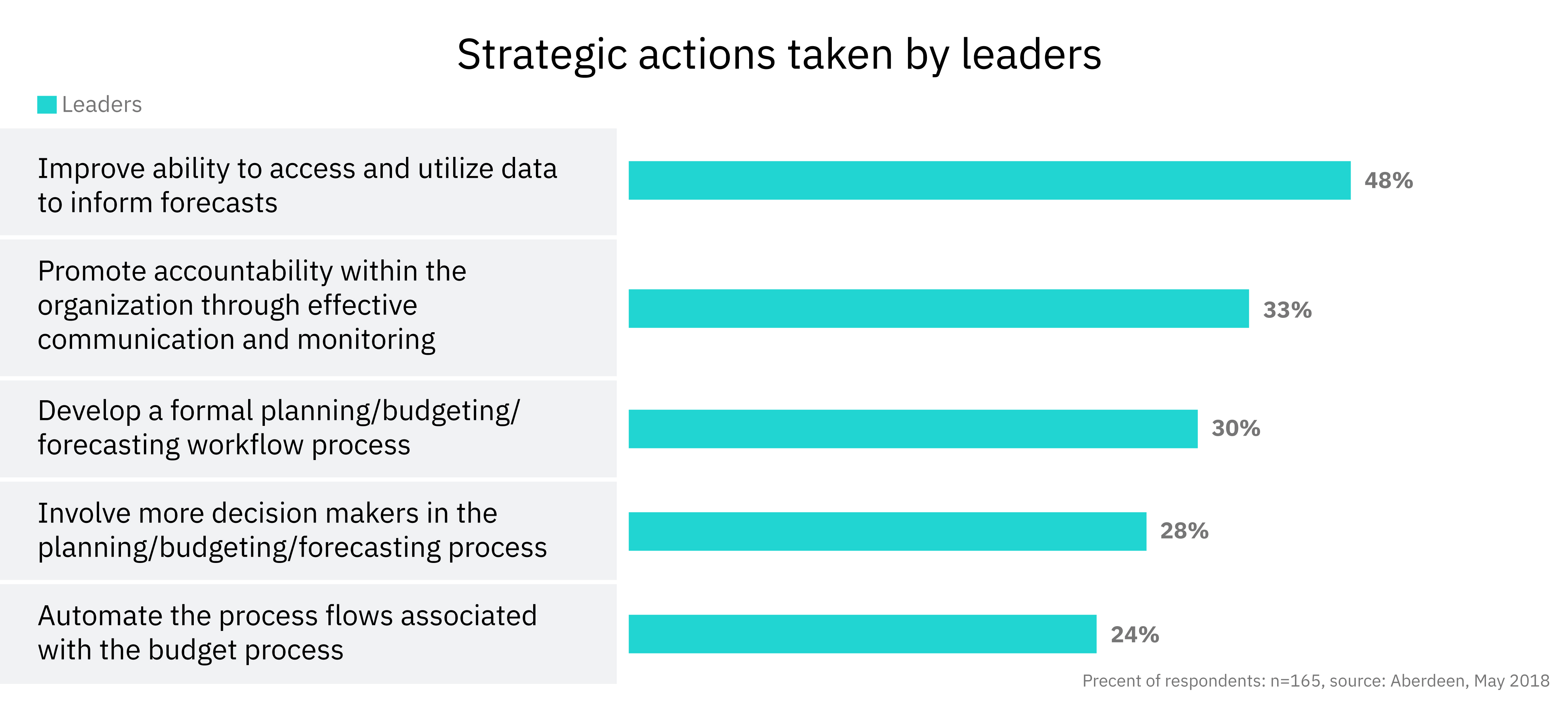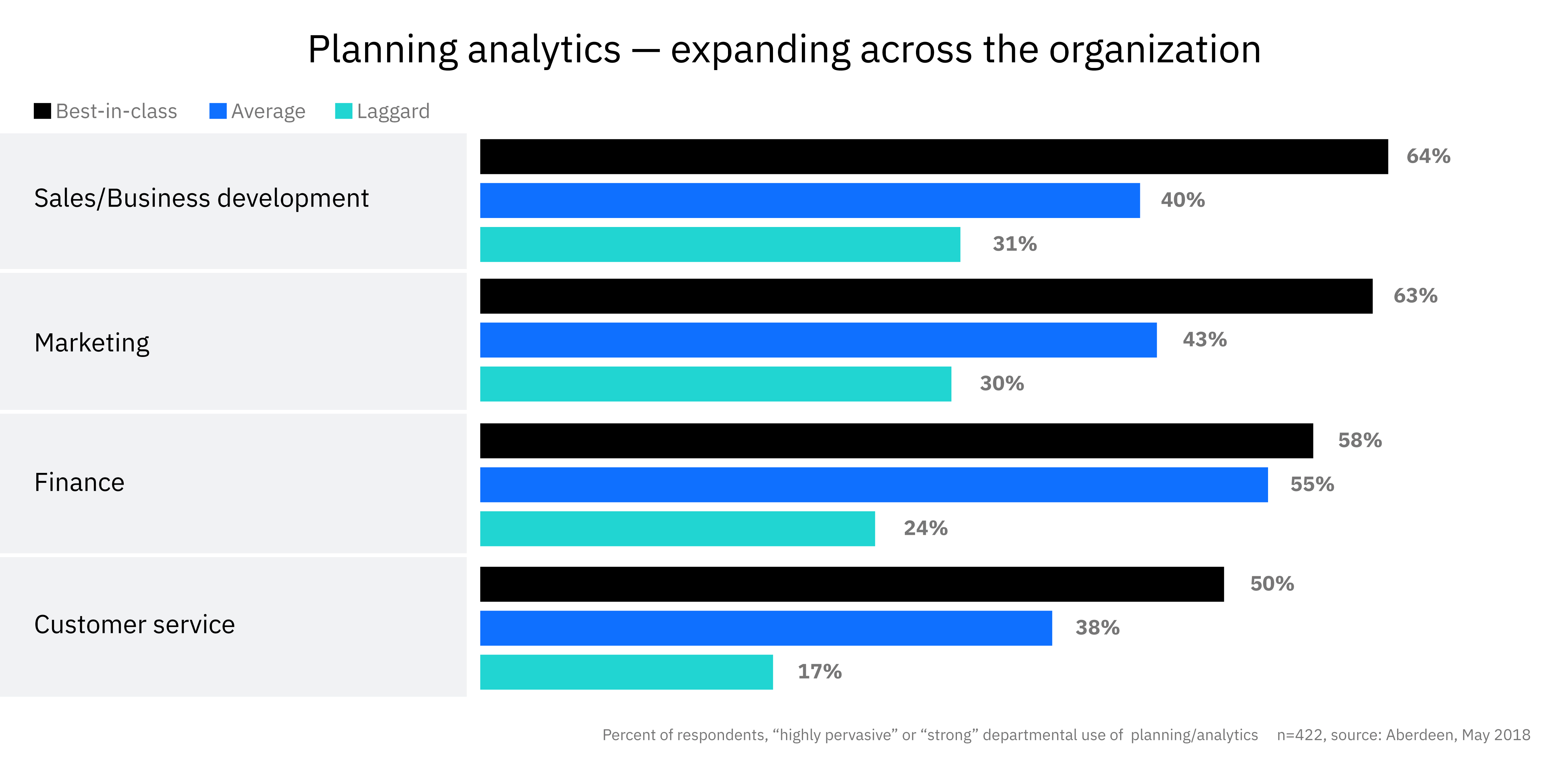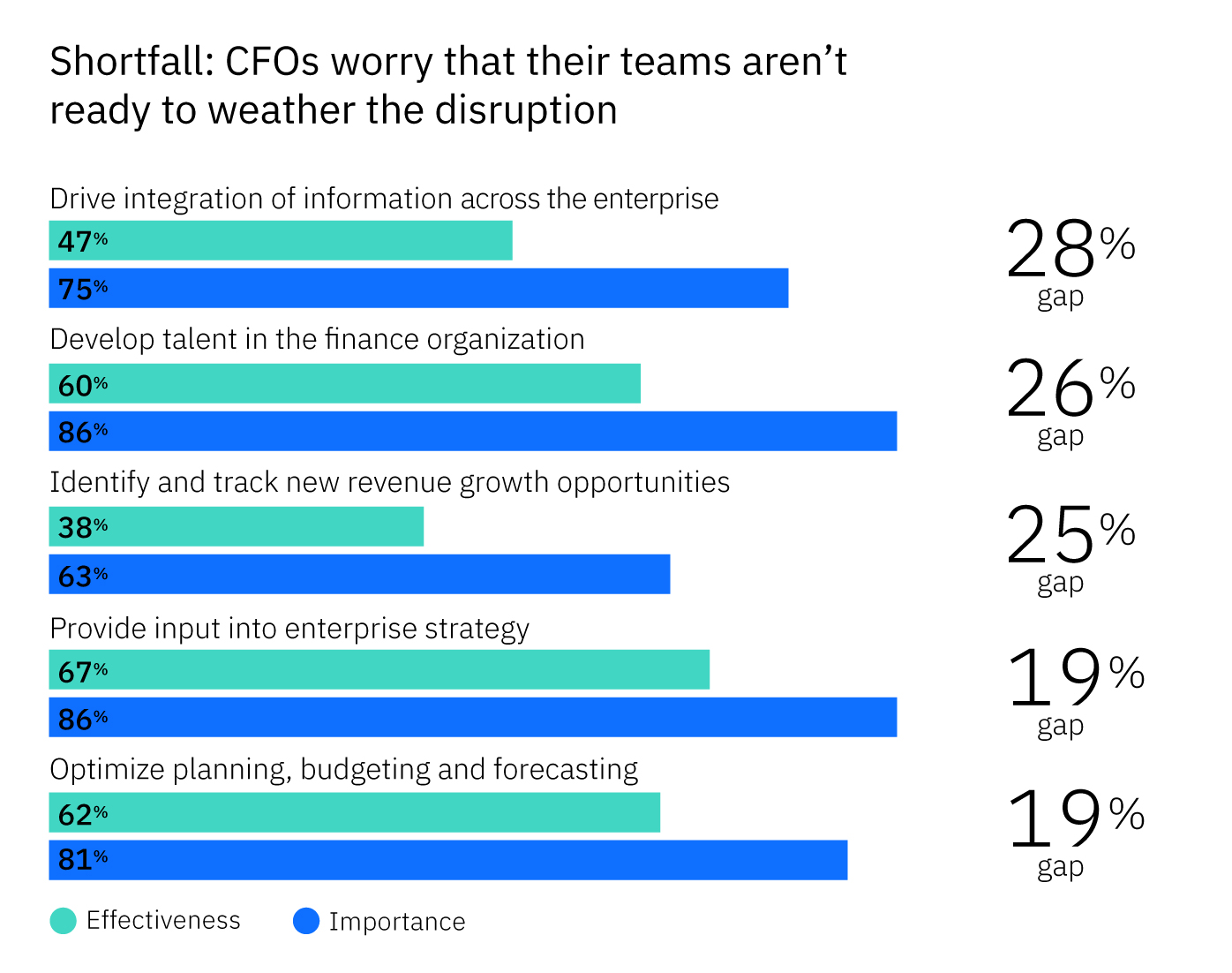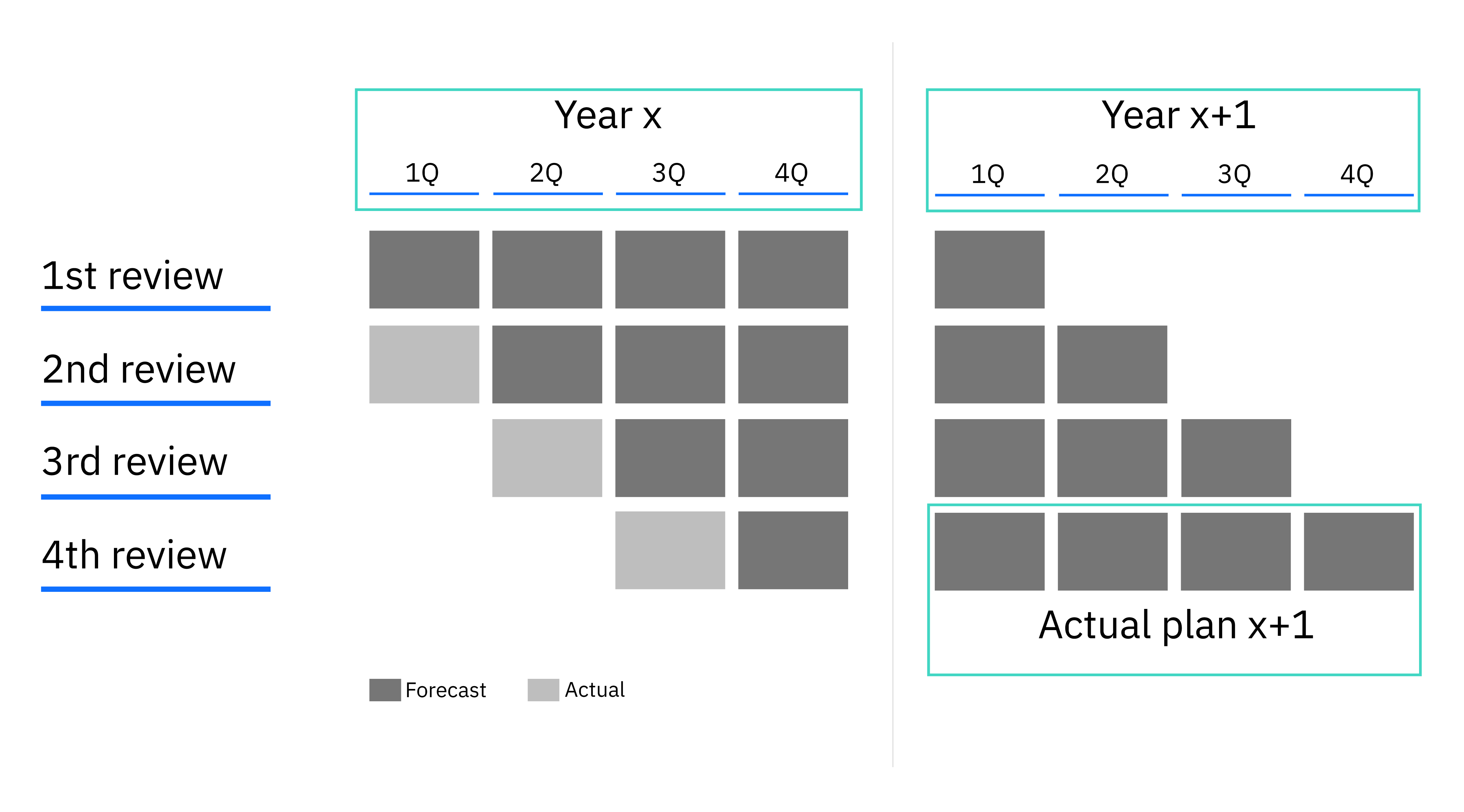Integrated planning:
The key to agile enterprise performance management
Integrated planning:
The key to agile enterprise performance management
Table of contents
Table of contents
Key points
Overview
Integration is key to streamlined planning, budgeting, and forecasting. In order to adapt to today's quickly changing business conditions, you need an enterprise performance management solution that creates a single source of truth and delivers speed and agility to your planning process.
Did you know that 33 percent of critical information is delivered late?
The delay of critical information can cause a ripple effect that drives poor decision making and poor results. Today’s business simply cannot afford this type of cost in our customer-centric environment, where data is one of our most valuable assets. To stay ahead of the competition, businesses rely on a solution that can deliver acceleration, agility, and collaboration in every part of the organization.

Integrated planning ensures all parts of the organization are connected and planning is streamlined.
What is integrated planning?
A must in the culture of “now.”
In virtually all industries, work has become more interactive and collaborative. More sharing is required, and more data is available than ever before. Success means integrating information across strategic and operational perspectives, as well as different functional and external sources.
Integrated planning mirrors the modern way we do business — it elevates the critical value of collaboration and cuts through data silos, driving more access to information and faster insights. Leaders use highly collaborative approaches to plan, budget, and forecast. Business planning requires accurate and complete data and buy-in across the entire organization, both from the top down and the bottom up. It sounds simple, but organizational silos are some of the biggest obstacles to accomplishing good work because they hinder critical decisions that strategically steer the business. And at the modern enterprise, silos are everywhere.
Integrated planning starts with a sophisticated planning platform that everyone in the organization can use, creating one source of truth. Data from diverse data sources such as ERPs, CRMs, and HRMs is unified, so users can access the information they need when they need it. Integrated planning helps ensure that plans, budgets, and forecasts are created with a holistic approach. Trends are easier to spot and quickly act on with more accurate and reliable plans. According to analysts at the Aberdeen Group, those organizations that champion data accessibility and collaboration between stakeholders promote organizational accountability and decrease time-to-decisions while increasing revenue.1
The fact of the matter is that without effective communication, coordination, and collaboration between stakeholders, there is no way to improve organizational performance.1
Bringing together people, data, and technology leaves organizations well-poised for optimal performance. Most importantly, integrated planning enables employees to be agile in responding to changing circumstances and able make the best decisions possible — all at the speed of modern business.
According to an Aberdeen study,1 leaders who adopt enterprise performance management tools show a keen understanding of the importance of collaboration. They recognize that to make data driven decisions, they need to make all information accessible by integrating data and breaking down silos. Figure 1 shows steps taken by leaders to democratize data and drive more accurate forecasts.

Figure 1
Leaders put a high value on data integration and accessibility. They see the value of providing real-time data to decision makers and taking the guesswork out of forecasting. These strategies create comprehensive, actionable visibility into overall company performance and drive better results.
Gartner Predicts by 2020, at least 25 percent of large organizations will increase planning accuracy by integrating key operational planning processes with financial planning and analysis.2
Poll
Do you have an integrated view of your data?
I do not feel confident in where to find comprehensive data, even for just my department
I have a good handle on my own departmental data (but only mine)
I have access to my data and that of other departments that impact my planning
Poll
Do you have an integrated view of your data?
I do not feel confident in where to find comprehensive data, even for just my department
I have a good handle on my own departmental data (but only mine)
I have access to my data and that of other departments that impact my planning
Poll
Do you have an integrated view of your data?
I do not feel confident in where to find comprehensive data, even for just my department
I have a good handle on my own departmental data (but only mine)
I have access to my data and that of other departments that impact my planning
IBM Planning Analytics helps Deutsche Bahn unite its global enterprise
Deutsche Bahn AG is a German railway company, and one of the largest IBM Planning Analytics customers with over 6,000 users worldwide. Deutsche Bahn uses IBM Planning Analytics to unite their wide-ranging operations across the globe, ensuring that the most accurate data is being used to create critical plans and forecasts that drive their business forward.
Change as a given: The truth about plans
The truth about plans is that they always change. The goal of a dynamic, integrated planning approach is not to create a perfect, fixed plan. It’s to use all the resources available to create the most accurate, flexible and transparent plan possible, using a solution that does more than just plan — it analyzes data, reveals trends, and allows for real-time iteration.
Better, quicker access to data means faster and more informed decisions, laying the foundation for an organization to be agile and ready to pivot when changing business conditions demand.
If you’re reading this and thinking, “great, the finance team integrates all our plans, so we are off the hook,” think again. While we’d like to think that finance is the well-informed master of plans, miraculously weaving them together in perfect harmony and balance, that’s not always the case. In fact, it rarely is. Many, many finance teams rely on the manual collection of data into spreadsheets, which are often disconnected. Remember that much of an organization’s critical planning starts outside of finance and never gets communicated back up the chain or across the organization. There are simply too many top-down and bottom-up communication problems. Spreadsheets only complicate smooth communications. When a finance person is collecting and analyzing budget spreadsheets from across the organization, there is high risk for error in the process of combining and editing, causing confusion at the highest levels. Contradictory data can inhibit a clear picture of what is actually going on and identifying business drivers or detractors. Spreadsheets have proven over and over to be a highly imperfect yet highly common business practice.
With real-time access to data, companies take the guesswork out of planning, decreasing time involved in forecasting and increasing forecast accuracy.3
5 spreadsheet hazards
Aside from outright errors, spreadsheets can present other limitations and drawbacks when organizations try to use them for large-scale performance management.
Wasted time
Conflicting versions of the truth
Missing insights from the front lines of the business
Inability to react quickly to changes
Spreadsheets painful to maintain
BARC’s research found that 53 percent of those who use specialized planning tools experience high quality results vs. the 5 percent who use spreadsheets.4
Planning across the organization
Bye bye, silos. Hello, cross-functional planning.
A centralized, automated solution for performance data and planning allows coordination between different parts of the business and enables more streamlined, accurate plans. Leadership needs to understand what is truly driving the business — what causes increases and decreases in revenue or demand. At every level, access to a full range of data is critical to understanding how change (both internal and external) impacts the business. Though planning often starts with finance, other areas of the business can benefit from a dynamic planning solution as well. Let’s dive into a few use cases.

Supply chain planning
The term “operations” covers an enormous range of business activities. But one that’s almost universal is supply chain management. Supply chain planners are under constant pressure to reduce costs, increase efficiency and improve margins. Unfortunately, too many of them lack visibility into data and are misaligned with other teams. One centralized tool can help connect operational tactics with financial plans to allocate resources more effectively in response to market opportunities or competitive threats. This helps planners avoid mismatched data across multiple spreadsheets and enables them to pivot in the case of supply chain disruptions.
“Our managers all have quick, easy access to the latest operational data via detailed reports that help them make better-informed decisions to improve the efficiency of the entire supply chain.”
- Homarjun Agrahari, Director, Advanced Analytics, FleetPride
Learn more about supply chain planning

Workforce planning
A company is only as good its people. That’s why it’s so important to hire and retain the right talent. Alignment between HR, finance and operations is crucial to ensure that the right people are in the right roles at the right time in order to meet organizational demands. This is rarely a simple task and too often it involves manual spreadsheet-based processes. Ensuring that departmental staffing targets are in sync with broader organizational objectives requires high levels of planning integration.
“Our business is based on people. IBM Analytics is helping us manage that critical asset much more efficiently and effectively than ever before. ”
- Nadia Bertoncini, Coordinator of Governance, Projects and HR Analytics for Latin America, Natura Cosméticos
Learn more about workforce planning

Sales planning
Misalignment between finance, marketing and sales could lead to investment in the wrong initiatives, missed opportunities and inaccurate revenue forecasts that can severely hinder sales growth. And in a fast-moving market, manual processes and siloed systems are detrimental to agility. Decisions that are based on outdated information can lead to misguided sales strategies and thus lost sales and lost revenue. It’s critical to unite data under one roof for one single view to boost sales and effectively manage sales people.
“The sheer level of detail that IBM Planning Analytics provides is very impressive … We can calculate our sales and gross margins for each SKU in IBM Planning Analytics and generate insightful reports at the click of a button. As a result, senior managers can rapidly access the comprehensive information they need to make effective strategic decisions.”
- Vince Mertens, Group Accounting and Consolidation Manager, Continental Foods
Learn more about sales planning

Marketing planning
Constantly changing customer preferences and rising customer expectations require marketers to interpret high volumes of data and respond appropriately. But siloed data systems give only a partial picture and hinder smart decision-making. In addition, marketing teams can be fragmented and often disconnected from sales. Siloed planning causes misalignment with overall marketing goals, driving misallocated spend on the wrong elements of the marketing mix. Manual, siloed processes reduce visibility into how marketing activities affect one another, how marketing and sales touches move a lead through the funnel and how marketing helps achieve overall financial and business goals.
“We first needed a better handle on our sales data. With so many lines of business, channels, and franchisees, collecting and consolidating this information was something that we knew we could do better.”
- Donald Neumann, Demand Manager, Grupo Boticário
Learn more about marketing planning

IT planning
With IT, you need a business case for every dollar spent. But balancing the IT needs of an entire organization with digital transformation objectives and constant technology innovation is no simple task, and often requires additional resources. That’s why it’s so important leverage a planning solution that keeps IT focused on the projects that matter, automates planning tasks, gives a clear view into resources available and helps measure ROI. It’s also critical to coordinate with both finance and human resources to ensure the right resources are provided for IT initiatives and projects.
“A few years ago, my team probably spent around half their time just keeping everything running — now it’s around 10 percent. With the move to IBM Analytics in the IBM Cloud, we have 40 percent more time to focus on working with the business to add value. Instead of asking ‘how do I make it work?’ we ask ourselves ‘how do I make it better?’ It’s a quantum shift in mindset.”
- Vimal Dev, Vice President – IT, Global Enterprise Applications Leader, Genpact
Learn more about IT planning
The ultimate integrated planning solution
Operations, sales, marketing, human resources and other departments and disciplines all have a need for fast, flexible planning and analysis. And all of them can use the same tools to provide insight and manage performance. When people in one part of the organization see how their decisions affect other parts of the organization, all of the activities will be better coordinated and drive better results. In fact, according to Aberdeen, leading organizations are those who align planning across departments at double the rate of laggards in areas like sales, marketing and finance.

Become a leader
With IBM Planning Analytics, you can break down silos and generate an integrated view of your departmental or organizational performance. The solution enables you to create more accurate forecasts, identify potential performance gaps before they occur and make resource allocation decisions quickly and intelligently. Using multidimensional modeling and scenario analysis, IBM Planning Analytics lets you drill down into your data to examine the ripple effects of alternative courses of action and understand how your decision will affect related areas of the organization and ultimately impact the bottom line.
Using what-if scenario analysis to make smarter decisions
With IBM Planning Analytics, you can build multidimensional models and perform “what-if” analysis to explore scenarios or test business assumptions. Creating and maintaining sophisticated models with advanced sandboxing capabilities is simple. Easily test business assumptions and model scenarios to immediately see the impact of alternative courses of action on before deciding to implement changes.
IBM Planning Analytics offers all areas of your business — finance, operations, HR, sales, marketing, operations, IT and more — the ability to solve problems today and respond to new challenges with agility tomorrow.
Click on any quadrant for more information.
Next steps

Dive deeper into the solution
Find out if IBM Planning Analytics is right for you.

Download the white paper
Download and save the PDF version of this SmarterPaper.

Try the interactive demo
Experience an interactive demo to get a real taste of functionality.
Sources
2 Gartner Predicts 2018: SaaS Financial Management Applications Increase Integration, Automation and Sophistication
3 “Analytics-Powered Enterprise Performance Management” Aberdeen, 2018
4 “How Budgeting Software Outperforms Excel” BARC 2016
Table of contents
Overview
Overview
Integration is key to streamlined planning, budgeting, and forecasting. In order to adapt to today's quickly changing business conditions, you need an enterprise performance management solution that creates a single source of truth and delivers speed and agility to your planning process.
Did you know that 33 percent of critical information is delivered late?
The delay of critical information can cause a ripple effect that drives poor decision making and poor results. Today’s business simply cannot afford this type of cost in our customer-centric environment, where data is one of our most valuable assets. To stay ahead of the competition, businesses rely on a solution that can deliver acceleration, agility, and collaboration in every part of the organization.

Integrated planning ensures all parts of the organization are connected and planning is streamlined.
What is integrated planning?
What is integrated planning?
A must in the culture of “now.”
In virtually all industries, work has become more interactive and collaborative. More sharing is required, and more data is available than ever before. Success means integrating information across strategic and operational perspectives, as well as different functional and external sources.
Integrated planning mirrors the modern way we do business — it elevates the critical value of collaboration and cuts through data silos, driving more access to information and faster insights. Leaders use highly collaborative approaches to plan, budget, and forecast. Business planning requires accurate and complete data and buy-in across the entire organization, both from the top down and the bottom up. It sounds simple, but organizational silos are some of the biggest obstacles to accomplishing good work because they hinder critical decisions that strategically steer the business. And at the modern enterprise, silos are everywhere.
Integrated planning starts with a sophisticated planning platform that everyone in the organization can use, creating one source of truth. Data from diverse data sources such as ERPs, CRMs, and HRMs is unified, so users can access the information they need when they need it. Integrated planning helps ensure that plans, budgets, and forecasts are created with a holistic approach. Trends are easier to spot and quickly act on with more accurate and reliable plans. According to analysts at the Aberdeen Group, those organizations that champion data accessibility and collaboration between stakeholders promote organizational accountability and decrease time-to-decisions while increasing revenue.1
The fact of the matter is that without effective communication, coordination, and collaboration between stakeholders, there is no way to improve organizational performance.1
Bringing together people, data, and technology leaves organizations well-poised for optimal performance. Most importantly, integrated planning enables employees to be agile in responding to changing circumstances and able make the best decisions possible — all at the speed of modern business.
According to an Aberdeen study,1 leaders who adopt enterprise performance management tools show a keen understanding of the importance of collaboration. They recognize that to make data driven decisions, they need to make all information accessible by integrating data and breaking down silos. Figure 1 shows steps taken by leaders to democratize data and drive more accurate forecasts.

Figure 1
Leaders put a high value on data integration and accessibility. They see the value of providing real-time data to decision makers and taking the guesswork out of forecasting. These strategies create comprehensive, actionable visibility into overall company performance and drive better results.
Gartner Predicts by 2020, at least 25 percent of large organizations will increase planning accuracy by integrating key operational planning processes with financial planning and analysis.2
Poll
Do you have an integrated view of your data?
I do not feel confident in where to find comprehensive data, even for just my department
I have a good handle on my own departmental data (but only mine)
I have access to my data and that of other departments that impact my planning
Poll
Do you have an integrated view of your data?
I do not feel confident in where to find comprehensive data, even for just my department
I have a good handle on my own departmental data (but only mine)
I have access to my data and that of other departments that impact my planning
Poll
Do you have an integrated view of your data?
I do not feel confident in where to find comprehensive data, even for just my department
I have a good handle on my own departmental data (but only mine)
I have access to my data and that of other departments that impact my planning
IBM Planning Analytics helps Deutsche Bahn unite its global enterprise
Deutsche Bahn AG is a German railway company, and one of the largest IBM Planning Analytics customers with over 6,000 users worldwide. Deutsche Bahn uses IBM Planning Analytics to unite their wide-ranging operations across the globe, ensuring that the most accurate data is being used to create critical plans and forecasts that drive their business forward.
Change as a given: The truth about plans
Change as a given: The truth about plans
The truth about plans is that they always change. The goal of a dynamic, integrated planning approach is not to create a perfect, fixed plan. It’s to use all the resources available to create the most accurate, flexible and transparent plan possible, using a solution that does more than just plan — it analyzes data, reveals trends, and allows for real-time iteration.
Better, quicker access to data means faster and more informed decisions, laying the foundation for an organization to be agile and ready to pivot when changing business conditions demand.
If you’re reading this and thinking, “great, the finance team integrates all our plans, so we are off the hook,” think again. While we’d like to think that finance is the well-informed master of plans, miraculously weaving them together in perfect harmony and balance, that’s not always the case. In fact, it rarely is. Many, many finance teams rely on the manual collection of data into spreadsheets, which are often disconnected. Remember that much of an organization’s critical planning starts outside of finance and never gets communicated back up the chain or across the organization. There are simply too many top-down and bottom-up communication problems. Spreadsheets only complicate smooth communications. When a finance person is collecting and analyzing budget spreadsheets from across the organization, there is high risk for error in the process of combining and editing, causing confusion at the highest levels. Contradictory data can inhibit a clear picture of what is actually going on and identifying business drivers or detractors. Spreadsheets have proven over and over to be a highly imperfect yet highly common business practice.
With real-time access to data, companies take the guesswork out of planning, decreasing time involved in forecasting and increasing forecast accuracy.3
5 spreadsheet hazards
Aside from outright errors, spreadsheets can present other limitations and drawbacks when organizations try to use them for large-scale performance management.
Wasted time
Conflicting versions of the truth
Missing insights from the front lines of the business
Inability to react quickly to changes
Spreadsheets painful to maintain
BARC’s research found that 53 percent of those who use specialized planning tools experience high quality results vs. the 5 percent who use spreadsheets.4
Planning across the organization
Planning across the organization
Bye bye, silos. Hello, cross-functional planning.
A centralized, automated solution for performance data and planning allows coordination between different parts of the business and enables more streamlined, accurate plans. Leadership needs to understand what is truly driving the business — what causes increases and decreases in revenue or demand. At every level, access to a full range of data is critical to understanding how change (both internal and external) impacts the business. Though planning often starts with finance, other areas of the business can benefit from a dynamic planning solution as well. Let’s dive into a few use cases.

Supply chain planning
The term “operations” covers an enormous range of business activities. But one that’s almost universal is supply chain management. Supply chain planners are under constant pressure to reduce costs, increase efficiency and improve margins. Unfortunately, too many of them lack visibility into data and are misaligned with other teams. One centralized tool can help connect operational tactics with financial plans to allocate resources more effectively in response to market opportunities or competitive threats. This helps planners avoid mismatched data across multiple spreadsheets and enables them to pivot in the case of supply chain disruptions.
“Our managers all have quick, easy access to the latest operational data via detailed reports that help them make better-informed decisions to improve the efficiency of the entire supply chain.”
- Homarjun Agrahari, Director, Advanced Analytics, FleetPride
Learn more about supply chain planning

Workforce planning
A company is only as good its people. That’s why it’s so important to hire and retain the right talent. Alignment between HR, finance and operations is crucial to ensure that the right people are in the right roles at the right time in order to meet organizational demands. This is rarely a simple task and too often it involves manual spreadsheet-based processes. Ensuring that departmental staffing targets are in sync with broader organizational objectives requires high levels of planning integration.
“Our business is based on people. IBM Analytics is helping us manage that critical asset much more efficiently and effectively than ever before. ”
- Nadia Bertoncini, Coordinator of Governance, Projects and HR Analytics for Latin America, Natura Cosméticos
Learn more about workforce planning

Sales planning
Misalignment between finance, marketing and sales could lead to investment in the wrong initiatives, missed opportunities and inaccurate revenue forecasts that can severely hinder sales growth. And in a fast-moving market, manual processes and siloed systems are detrimental to agility. Decisions that are based on outdated information can lead to misguided sales strategies and thus lost sales and lost revenue. It’s critical to unite data under one roof for one single view to boost sales and effectively manage sales people.
“The sheer level of detail that IBM Planning Analytics provides is very impressive … We can calculate our sales and gross margins for each SKU in IBM Planning Analytics and generate insightful reports at the click of a button. As a result, senior managers can rapidly access the comprehensive information they need to make effective strategic decisions.”
- Vince Mertens, Group Accounting and Consolidation Manager, Continental Foods
Learn more about sales planning

Marketing planning
Constantly changing customer preferences and rising customer expectations require marketers to interpret high volumes of data and respond appropriately. But siloed data systems give only a partial picture and hinder smart decision-making. In addition, marketing teams can be fragmented and often disconnected from sales. Siloed planning causes misalignment with overall marketing goals, driving misallocated spend on the wrong elements of the marketing mix. Manual, siloed processes reduce visibility into how marketing activities affect one another, how marketing and sales touches move a lead through the funnel and how marketing helps achieve overall financial and business goals.
“We first needed a better handle on our sales data. With so many lines of business, channels, and franchisees, collecting and consolidating this information was something that we knew we could do better.”
- Donald Neumann, Demand Manager, Grupo Boticário
Learn more about marketing planning

IT planning
With IT, you need a business case for every dollar spent. But balancing the IT needs of an entire organization with digital transformation objectives and constant technology innovation is no simple task, and often requires additional resources. That’s why it’s so important leverage a planning solution that keeps IT focused on the projects that matter, automates planning tasks, gives a clear view into resources available and helps measure ROI. It’s also critical to coordinate with both finance and human resources to ensure the right resources are provided for IT initiatives and projects.
“A few years ago, my team probably spent around half their time just keeping everything running — now it’s around 10 percent. With the move to IBM Analytics in the IBM Cloud, we have 40 percent more time to focus on working with the business to add value. Instead of asking ‘how do I make it work?’ we ask ourselves ‘how do I make it better?’ It’s a quantum shift in mindset.”
- Vimal Dev, Vice President – IT, Global Enterprise Applications Leader, Genpact
Learn more about IT planning
The ultimate integrated planning solution
The ultimate integrated planning solution
Operations, sales, marketing, human resources and other departments and disciplines all have a need for fast, flexible planning and analysis. And all of them can use the same tools to provide insight and manage performance. When people in one part of the organization see how their decisions affect other parts of the organization, all of the activities will be better coordinated and drive better results. In fact, according to Aberdeen, leading organizations are those who align planning across departments at double the rate of laggards in areas like sales, marketing and finance.

Become a leader
With IBM Planning Analytics, you can break down silos and generate an integrated view of your departmental or organizational performance. The solution enables you to create more accurate forecasts, identify potential performance gaps before they occur and make resource allocation decisions quickly and intelligently. Using multidimensional modeling and scenario analysis, IBM Planning Analytics lets you drill down into your data to examine the ripple effects of alternative courses of action and understand how your decision will affect related areas of the organization and ultimately impact the bottom line.
Using what-if scenario analysis to make smarter decisions
With IBM Planning Analytics, you can build multidimensional models and perform “what-if” analysis to explore scenarios or test business assumptions. Creating and maintaining sophisticated models with advanced sandboxing capabilities is simple. Easily test business assumptions and model scenarios to immediately see the impact of alternative courses of action on before deciding to implement changes.
IBM Planning Analytics offers all areas of your business — finance, operations, HR, sales, marketing, operations, IT and more — the ability to solve problems today and respond to new challenges with agility tomorrow.
Integrated Business Planning
Click on any quadrant for more information.
Next steps
Next steps

Dive deeper into the solution
Find out if IBM Planning Analytics is right for you.

Download the white paper
Download and save the PDF version of this SmarterPaper.

Try the interactive demo
Experience an interactive demo to get a real taste of functionality.
Sources
Sources
2 Gartner Predicts 2018: SaaS Financial Management Applications Increase Integration, Automation and Sophistication
3 “Analytics-Powered Enterprise Performance Management” Aberdeen, 2018
4 “How Budgeting Software Outperforms Excel” BARC 2016

